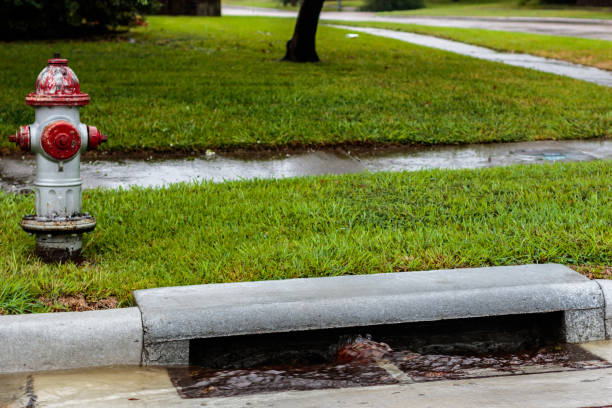Stormwater management plays a vital role in maintaining the health and safety of waterways. When rain falls on impervious surfaces like roads, rooftops, and parking lots, it cannot soak into the ground. Instead, it runs off, picking up pollutants along the way. Without proper management, this runoff can lead to significant environmental damage, posing risks to public health and ecosystems. Below, we explore the challenges of stormwater and effective solutions that help keep our waterways clean and safe.
The Importance of Stormwater Management
Stormwater contributes to the natural water cycle, but in urbanized areas, unmanaged runoff can become a major issue. Proper management ensures that waterways remain clear of harmful pollutants, benefiting both communities and wildlife.
Clean waterways are essential for providing safe drinking water, supporting aquatic habitats, and preventing flooding. However, without strategies to handle the runoff, pollutants like oil, pesticides, heavy metals, and plastic are often washed into rivers, lakes, and oceans. This not only harms marine life but also contaminates sources of drinking water vital to human health. Addressing these concerns is more important than ever as cities expand and extreme weather events grow more frequent.
Key Challenges in Stormwater Management
Managing stormwater is not without its challenges. Urban areas, in particular, face unique difficulties due to dense infrastructure and limited natural spaces.
Increased Runoff from Urbanization
Urban development often reduces the ground’s ability to absorb rainwater. Buildings, roads, and concrete surfaces prevent natural infiltration, leading to larger volumes of stormwater runoff. These surges can overwhelm existing drainage systems, resulting in localized flooding.
Pollution from Runoff
One of the greatest challenges is non-point source pollution. This refers to contaminants carried by stormwater from various sources, making it harder to control compared to pollution from a single, identifiable source. These pollutants can include:
- Sediment from construction sites
- Oil and grease from roadways
- Fertilizers and pesticides from landscaping
- Trash and debris from streets
Deterioration of Water Infrastructure
Aging or poorly designed stormwater systems may fail to keep up with increased runoff, especially during heavy rainfall. This can lead to backups, flooding, and accelerated wear and tear on public infrastructure, increasing repair costs and the need for upgrades.
Effective Stormwater Solutions
To combat these issues, a variety of innovative solutions can improve stormwater quality and reduce runoff volumes. These strategies can be implemented on both small and large scales, ensuring effective water management that benefits everyone.
Green Infrastructure
Green infrastructure uses natural processes to manage water where it falls, supporting infiltration and cleaning runoff. Popular examples include:
- Rain Gardens: These planted depressions absorb and filter runoff, reducing its flow into storm drains.
- Permeable Pavement: Unlike traditional concrete, this allows water to soak through and recharge groundwater.
- Green Roofs: Covering rooftops with vegetation slows runoff and improves insulation, offering dual benefits.
Such solutions also contribute to local aesthetics, reduce heat island effects, and provide habitats for wildlife.
Stormwater Management Plans
Municipalities and construction projects often require comprehensive plans to control and treat stormwater runoff effectively. These plans identify sources of pollution, establish preventative practices, and incorporate strategies to mitigate environmental impacts. Programs like Utah SWPPP ensure regulatory compliance while protecting local waterways from sediment and pollutant overload.
Retention and Detention Systems
Structural methods such as retention ponds and detention basins hold stormwater and release it slowly over time. Retention systems are designed to allow some water to soak into the landscape, while detention systems temporarily store water before draining it downstream. Both reduce flood risks and prevent erosion.
Public Education and Community Engagement
Communities play an integral role in keeping waterways clean. Educating residents about the importance of disposing of waste properly, maintaining vehicles to avoid oil leaks, and using minimal fertilizers can significantly reduce pollution. Workshops and awareness programs for businesses also encourage adherence to stormwater best practices.
The Future of Stormwater Management
The ongoing threat of climate change adds an extra layer of urgency to improving stormwater management systems. With heightened instances of intense rainfall and unpredictable weather patterns, communities must adopt resilient and sustainable approaches. Investment in modern infrastructure and widespread use of innovative technologies will ensure waterways remain a healthy resource for future generations.
Stormwater management is not a one-size-fits-all process. It requires collaboration between governments, businesses, and individuals. When we work together, we can effectively tackle the challenges posed by runoff and promote a cleaner, safer environment for everyone.
By employing preventive measures, implementing green technologies, and fostering an aware community, we can protect our waterways from pollution and degradation. The health of our water systems is inextricably linked to the health of our planet—and everyone has a role to play in safeguarding it.


